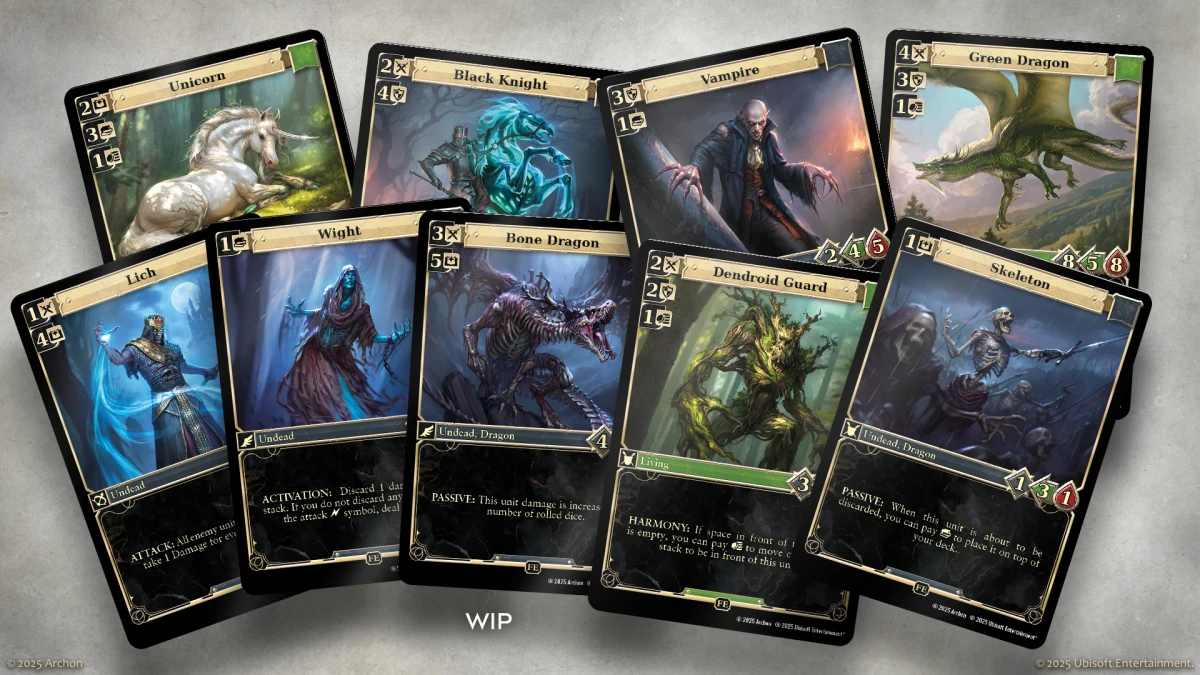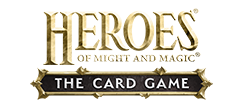- Brands
-
Shop
-
Dungeons & Lasers
-
Rampart
-
Masters of The Universe: Battleground
-
Masters of The Universe: Fields of Eternia
-
Heroes of Might & Magic III: The Board Game
-
World of Tanks: The Card Game
-
StarCraft Tabletop Miniatures Game
-
Trench Crusade
-
Starfinder
-
- Newest
- Bestsellers
- Pre-orders
The Narrative Direction of Heroes of Might & Magic — Interview with Vicky Malineau
Posted on Monday,
21.07.2025
By Aleksandra Adamczyk
Selected language
EN
- DE
- ES
- FR
- PL
.png/1056_630_crop.png?ts=1753277588&pn=cover)
When talking about Might & Magic, especially Heroes of Might & Magic, there’s one thing the fans hold especially dear: the world, the characters and the lore. Behind the curtain of recent projects, including the upcoming Heroes of Might and Magic: The Card Game, is someone whose job is to ensure that magic remains intact—Vicky Malineau, Narrative Director for the franchise at Ubisoft.
Table of Contents
- About Vicky Malineau
- Interview - The Narrative Direction of Heroes of Might and Magic
- Final thoughts and Reflections
About Vicky Malineau
 Vicky Malineau
Vicky Malineau
The Narrative Director for the Might & Magic franchise at Ubisoft. She oversees the lore and artistic consistency of the IP across all projects, including collaborations like Heroes of Might & Magic III: The Board Game and its upcoming card game adaptation, Heroes of Might and Magic: The Card Game. Vicky is a huge fan of fantasy and science-fiction, nurtured with role playing games (both pen and paper and on computers), miniature wargames and card games during her whole childhood.
Interview - The Narrative Direction of Heroes of Might and Magic
With the 30th anniversary of the series drawing near, the Heroes of Might & Magic franchise is not just looking back, but also forward. The renewed push with projects like Heroes of Might and Magic III: The Board Game and now Heroes of Might & Magic: The Card Game shows both celebration and nostalgia surrounding this IP. We had the chance to talk to Vicky about what that means from a creative and narrative perspective—how the universe evolves, how visual styles are chosen, and how to carry the legacy into new formats like card games and miniatures.
Here’s what she had to say.
Q: As the Narrative Director of the Might and Magic universe you’re familiar with this IP more than anyone. Why did Heroes of Might and Magic: The Card Game adopt such a particular style, which clearly differs from that of Heroes of Might and Magic III: The Board Game?
A: Before talking about art style, I think we must consider that Heroes of Might and Magic III: The Board Game and Heroes of Might and Magic: The Card Game are two vastly different projects. With the Board Game, we were in a situation where we wanted to keep the visual language and design of Heroes 3 while modernizing the execution. The major reason for that was that Heroes 3 is already quite akin to a digital board game, so when approaching that project it felt natural to lean on the original game and make it the official physical version in a way. But because we were nearly 25 years later, using the pixelated visuals was not an option and we opted to redo things, in a modernized execution. With the card game, I feel that we are entering a new era for the IP, we do not only modernize the execution and appeal to nostalgia, we also want to take the visual design into a new era. The visual style of the card game follows the vision we want to pursue with the future of HoMM, a grounded yet magical and hopeful world.
Q: You’ve been closely involved in ensuring the visual consistency of the Might and Magic IP. What do you look for when approving artwork for projects like the Heroes of Might and Magic: The Board Game or the Heroes of Might and Magic: The Card Game?
A: As I have touched upon above, with the board game, the idea was to keep all the visual design from Heroes 3. Yes, it did involve some archaeology to understand what some of the elements were behind the pixels, but in a way the board game was following Heroes 3’s creative decisions. In other words, if it was inconsistent with Heroes 3, the art would have to be redone. In the card game, we are going beyond that in what I feel is another equally exciting creative endeavor. With the card game we are now thinking “what is this creature’s existence in this world? What does their daily life look like? Do they reproduce or are they summoned? Are they magical or physical in nature?” and all those questions inform the design. In the end, what we get is still following the overarching ideas developed in Heroes 3 (and other games in the Enroth franchise) but I feel that we are going a step further into adapting them to our new era of fantasy. It is a balancing exercise between keeping the past celebrated and building a new future.

Q: Are there any specific challenges you've encountered when overseeing the translation of the iconic Heroes designs into new formats like card games or miniatures?
A: With miniatures, the biggest challenge we faced was how to translate small details with the level of tolerance of the molds. A lot of work involved finding how to express the creature’s identity with those constraints. When it comes to 2D illustration the issue is somehow reversed, we now have a lot of space to be filled with tons of details that the original Heroes 3 never really had the opportunity to touch and so this is where creativity is required. In both cases, hard work on the lore and world building was necessary, either to tell a longer story with less details in the case of miniatures, or to create a lot of nuances with many smaller details.
Q: How do you work with external partners like Archon Studio to ensure that their vision aligns with Ubisoft’s narrative and visual standards?
A: With Archon Studio, we have slowly built a process and a trust over the years working together on several projects like the board game and the card game. We have regular discussions on the lore, on what it means for the artwork and how to best translate the mechanics of the IP into both visuals and rules.
Q: As the Heroes of Might & Magic franchise celebrates its 30th anniversary soon, what does this milestone mean to you personally?
A: It is honestly hard to believe that this is where I am as we are approaching the 30th anniversary of the franchise. As someone who already liked the franchise and loved fantasy, it was like a dream come true when I joined the IP team 12 years ago. But seeing how I am now in charge of the lore and development of this universe, having had a hand in the decision to come back to Enroth, I don’t think I would’ve believed it if I had known. What I want to express is that, working on an IP with such a long history, we understand that this world belongs to the community as much as it belongs to us and I have the most absolute respect for the fans and modders who have kept it alive all this time. In the end, we may have divergence in how we interpret the lore but to me all versions are valuable and deserve praise.

Q: What is your all-time favorite unit (or hero) from the Might & Magic universe?
A: My favorite hero is Mutare. She is so driven and has such a determination, to the point of choosing to become a dragon in order to achieve her dreams. I think that we can all find some wisdom in this character. My favorite unit is not from Dungeon though, and I would say the podium is shared between the Obsidian Gargoyle and the Dread Knight. In the case of the gargoyle, I love the idea of a pitch-black stone statue animated with magic, it has even more visual appeal than other constructs. And the Dread Knight has just always felt so good-looking to me, it is even cooler than the Nazgûl in Lord of the Rings, because it has this really ominous presence.
Final Thoughts and Reflections
Talking to Vicky gives us a glimpse behind the creative guardrails that keep the Might & Magic universe coherent, yet adaptable to new formats. Whether it’s the ominous Dread Knight, the enigmatic Obsidian Gargoyle, every piece of the world carries a story, and that’s exactly what Vicky and her team are preserving and expanding.
With the 30th anniversary of the series drawing close, Heroes of Might & Magic is not just looking back, but also forward. Regardless of the form—whether it’s a board game, card game, or something entirely new—people at Archon Studio always put a conscious effort to pay homage to this beloved series. As Vicky herself puts it, this world belongs to the fans just as much as it does to the creators. That’s why maintaining the lore, respecting the legacy, and staying true to the heart of the series is something we take incredibly seriously.
If you’re a fan of the Heroes universe, whether since 1995 or just getting into it, this new era of board games, card games, and hopefully more is shaping up to be worth the journey!









